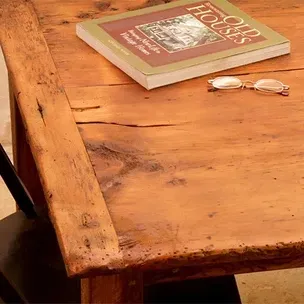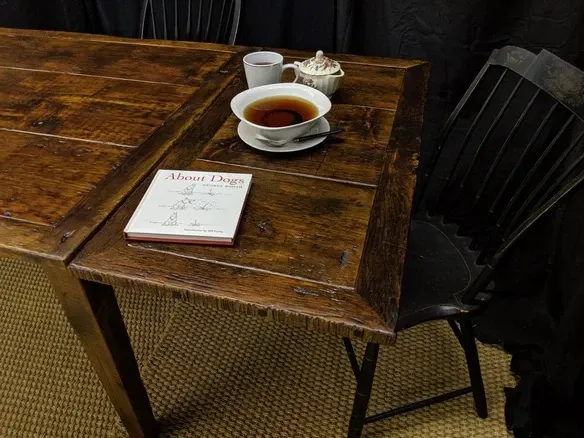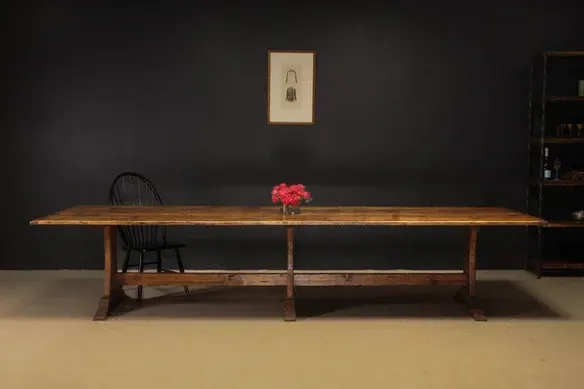Blog

By the time of the late summer of 2008, I had built what might have been the largest warehousing operation of historic materials and entire historic buildings in the country. We were having great success working with individual clients and developers all over the USA, largely because we were able to bring an interesting and very unique look to the projects by using entire buildings and other historic fabric to the projects. Our work was being published in major magazines and business was brisk and good. At that time, I had been asked to manage the look of all the work of a major Denver real estate developer with four major projects on the drawing board all over the Eastern US. Prior to those years, clients of mine from Atlanta, Georgia invited me to attend what was at that point the largest and most prestigious American Country antique show in America in Nashville, Tennessee. The show some of you may remember was called Heart of Country. I went to the show and was very, very impressed with everything there but one thing stood out for me. It was an exquisite farm table that, I was told, had been sold to a major Hollywood singer and actress for a very large sum of money. I inspected it carefully and my takeaway was that I could, using materials I already had in my possession, make a very, very good copy of that table. That was my very first thought that had anything to do with making furniture. Much later, about 15 years later, I was part of a project with two real estate friends of mine that centered around bringing in historic buildings and creating something along the lines of a small compound of houses that would be part of an old Inn. That Inn is now The Inn at Half Mile Farm in Highlands, NC. I brought in eight separate buildings and put them together to make three houses. The buildings I brought in were from the time periods of about circa 1805 to about the mid 1840’s. When it came time to address the cabinetry, I found what I suspected all along would be the situation and that was that there was nowhere to be found anything in the way of cabinetry that would work in a circa 1812 house. The solution was that we were going to have to make all the cabinetry for the houses ourselves and that is exactly what we did. I hired two wonderful older gentlemen from a rural part of our county to take over that task and told them that “we are going to make what was on your grandmother’s back porch”. The very first piece they made was a masterpiece copy of a Pennsylvania hanging corner cupboard. As we progressed with the project, we were required to also furnish the houses. We were having such great success that I decided I would also make as much of the furniture as we could. We made our very first table for that project. To end this story, the crash of the real estate market in 2008 brought a quick end to the work the developer had on his books and a slow melting away of the work I had been doing. But in every situation is found some kind of blessing. Mine was The Handmade Table. David Howard

By the time of the late summer of 2008, I had built what might have been the largest warehousing operation of historic materials and entire historic buildings in the country. We were having great success working with individual clients and developers all over the USA, largely because we were able to bring an interesting and very unique look to the projects by using entire buildings and other historic fabric to the projects. Our work was being published in major magazines and business was brisk and good. At that time, I had been asked to manage the look of all the work of a major Denver real estate developer with four major projects on the drawing board all over the Eastern US. Prior to those years, clients of mine from Atlanta, Georgia invited me to attend what was at that point the largest and most prestigious American Country antique show in America in Nashville, Tennessee. The show some of you may remember was called Heart of Country. I went to the show and was very, very impressed with everything there but one thing stood out for me. It was an exquisite farm table that, I was told, had been sold to a major Hollywood singer and actress for a very large sum of money. I inspected it carefully and my takeaway was that I could, using materials I already had in my possession, make a very, very good copy of that table. That was my very first thought that had anything to do with making furniture. Much later, about 15 years later, I was part of a project with two real estate friends of mine that centered around bringing in historic buildings and creating something along the lines of a small compound of houses that would be part of an old Inn. That Inn is now The Inn at Half Mile Farm in Highlands, NC. I brought in eight separate buildings and put them together to make three houses. The buildings I brought in were from the time periods of about circa 1805 to about the mid 1840’s. When it came time to address the cabinetry, I found what I suspected all along would be the situation and that was that there was nowhere to be found anything in the way of cabinetry that would work in a circa 1812 house. The solution was that we were going to have to make all the cabinetry for the houses ourselves and that is exactly what we did. I hired two wonderful older gentlemen from a rural part of our county to take over that task and told them that “we are going to make what was on your grandmother’s back porch”. The very first piece they made was a masterpiece copy of a Pennsylvania hanging corner cupboard. As we progressed with the project, we were required to also furnish the houses. We were having such great success that I decided I would also make as much of the furniture as we could. We made our very first table for that project. To end this story, the crash of the real estate market in 2008 brought a quick end to the work the developer had on his books and a slow melting away of the work I had been doing. But in every situation is found some kind of blessing. Mine was The Handmade Table. David Howard

The Refectory Table has a very interesting history and one that if you don’t know about it has a strong connection to current literary culture. When I talk about this table style, I start by saying “Think Hogwarts”. Yes, a classic example of the refectory table is in the Harry Potter movies. Allow me to explain further. The refectory was the dining room of the monasteries of the Middle Ages in Central and Western Europe. To symbolize equality, everyone ate at a very long table (think Hogwarts) in the largest room of the compound (think Hogwarts), which was the refectory. All that symbolism was beautiful but as a practical matter very problematic. When the Hall was not being used for dining, the ultra-long table became a problem with the efficiency of movement needed to facilitate any work that was going on in the room. Consider this; what would happen if you had to in a hurry get to the bathroom which was located diagonally on the other side of the room? Well, I suspect you get the point. It would be a long hike and you may or may not be able to get there, which even in the Middle Ages could create an embarrassing scene for you. The solution was that rather than have tables that butted end to end and blocked traffic flow some enterprising young monk came up with the idea to make the tables shorter than before and add a leaf at the end of each table that could be taken out of both tables to create a passageway between the tables. This would allow the occupants to move freely (almost anyway) through the room, end-to-end or diagonally. Great idea, but what were you going to do with all those leaves at the end of the meal? They had to be stored somewhere. So along comes Monk #2 who says, “Blessed Mary, I have an idea”. His idea was to make a drawer at the end of the table. When the meal was over, the drawers were opened and the leaves turned 90 degrees and stored right there in the drawer where they would be needed at the time of the next meal. It was such a good idea that it was used as a means of adding place settings to a table almost exclusively until the modern mechanical means of adding extensions came about in the late 1800s. Fun stuff huh? Thank you, David Grant Howard

My childhood friends and I refer to Armitage Drive, the street most of us grew up on, as the “cocoon”. I say that because it was a long time before any of us developed any sense that there was a much wider world out there. But even so, as a child, I always had an ingrained curiosity about why things are like they are. As I began to emerge from that cocoon, I not surprisingly developed a significant interest in history, so it is logical that I would develop an interest in the history of furniture. Let me be clear at the outset here that I am no scholar. If I have any scholarly attributes, I will say they are more like a drunk wandering down a hallway than someone with an intellectual laser focus. But even a drunk can sometimes make it to the end of a hallway so I have developed something of a decent base of knowledge of furniture. It is a long hallway and I have been walking a long time so I have picked up a tidbit or two to share. The topic in this post is the trestle table. In another post, I will take a look at the emergence of furniture of all types but this post looks specifically at the trestle table. While I can’t say with complete confidence where the trestle table originated it is reasonable to say that the emergence of it, at least in common use, was in the Great Halls of the castles of central and western Europe during the Middle Ages, and perhaps before that. In those days, everyone ate with the King or Duke in the Great Hall but the space of the Great Hall was used for many other purposes. This meant the tables needed to be moved out of the way for other functions to take place. The solution was to take the tables apart after the meals and place them at the sides of the room and bring them out and put them together again for the next meal. Those early and very primitive tables were large heavy slabs of wood that were placed, unattached, over two “trestles”. If this is new information to you, to understand this, think of a train trestle that has vertical supports holding up a track above (in our use, it is the tabletop). To provide more understanding the names of the parts in a trestle table are the top, the trestle, and a long piece of wood at the bottom called a stretcher. The stretcher held the base of the table together and stabilized the entire construction. I am providing a photo of a knock-down trestle style so you can see how all this fits together and would have been assembled and taken apart. You probably have seen this a zillion times but perhaps did not know what it was. When you look at the picture, you will see a wooden wedge at the end of the stretcher. When the table was to be taken apart and moved, the wedge was knocked out and the table would almost fall apart for the worker to make it easy to move. Finally, when the dining room emerged (more on this in a later post) the need to take the table down went away but the style and techniques of building trestle tables remained, largely because they were a very functional piece of furniture. Also, along with the evolution of this trestle style came many changes and refinements that moved the once lowly trestle table into the realm of fine furniture. I am including a few images for you. More to come soon, David Grant Howard

Blogging sounded very appealing to me when I first heard the term many years ago and now, better late than never, this is my first one. I find it fitting that I start with something seemingly unrelated to my business but upon closer inspection, my want for the first blog is very much related to business. The topic of this first blog is gratitude. This past weekend we graduated my youngest daughter from college. As I sat in this massive indoor arena and took in the scene of the immense volume of the building and the literally thousands of 20- to 22-year-old human beings below me dressed in splendid caps and gowns with tassels and such, I was struck by a deep sense of awe and gratitude. One of my mentors along my bumpy path in life used to say that every moment in our lives is an opportunity for awe and gratitude, no matter what its source, no matter what the circumstance. He was a great teacher and I was, how shall I put this, an average student. But some of what he had to say stuck and now as, how shall I put this, a seasoned adult, I periodically allow myself the space to have those moments. Saturday was one of them. Related to this topic, a few years ago I came across a quote that had a significant impact on me and I want to share it with you now. I cannot give proper credit to its creator because unfortunately, I have no idea who wrote it. But all the same, here it is: “How is it that in this infinite gaggle of galaxies and quasars, quarks, and black holes that somehow, I find myself here, in this place… with you?” Now think about this, of all the billions of people on this planet, what are the statistical chances that I would write something and you would read it, possibly, or likely thousands of miles away. If one keeps “pulling on that sting” as I like to say, what are the chances that of all the people in the world, anyone in your life right now, or in your past for that matter, would be there? Statistically it would be almost zero but here we are, in this place, together, at this time. So, what I want you to know is that I am grateful to be here, doing what I am doing and sharing my life and my talent and hopefully having a positive impact on the world through what I do. I know for a fact that my staff all feel the same way about it as I do. So, let’s see what happens next and allow for the moments of awe and gratitude to come forward. My warmest regards and best wishes to you. David Grant Howard #gratitude #graduation #personal #David #Grant #Howard
